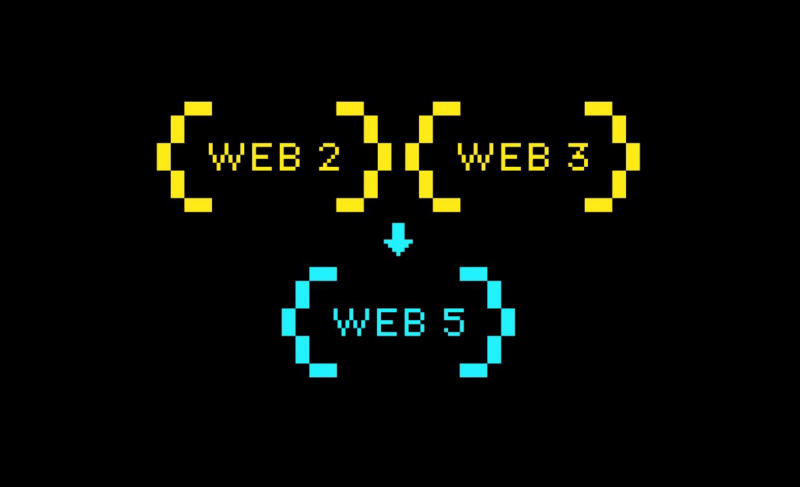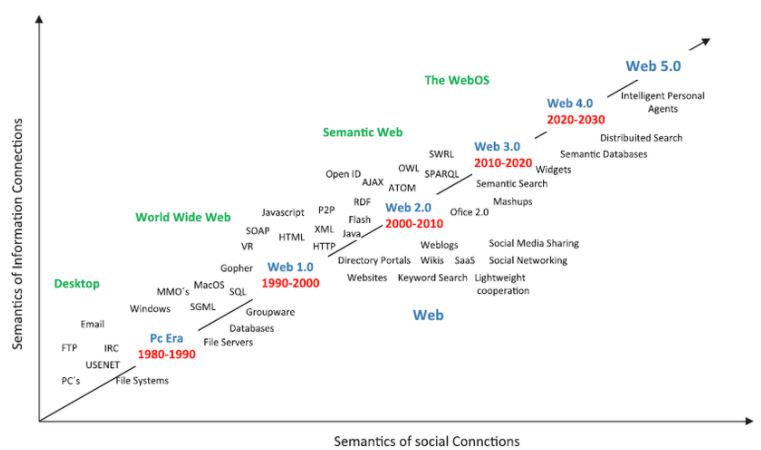Web5: The Rise of the Sentient Web
 Abraham Dahunsi
Abraham Dahunsi
Hello, fellow netizens! Imagine the next time you visit your favorite hotel website to book a room before a vacation trip, and the website suggests rooms that suit your preferences, like for example, rooms that are themed in your favorite colors and have balconies. You can even virtually tour your hotel room before you book it, using augmented reality technology to overlay the room onto your own living room to get a sense of the layout and help you decide if it's the right fit for you. The best part is that the hotel cannot store your data, and you can revoke their access to your data anytime you wish.
Another analogy could be if you just relocated to a new smart apartment. Instead of manually setting the new apartment to the way you like it, you can just share your preferences with the home's main system, and you just have to make little adjustments. This is the promise of the web, which seamlessly integrates with our lives. It would identify individual strengths and weaknesses, providing customized learning paths that cater to specific needs. Gone are the days of one-size-fits-all educational approaches; the sentient web would ensure that every student receives the optimal learning experience, unlocking their full potential. This is the promise of the sentient web - Web5.
How Did We Get To Web5?
It's summer of 2022, and the crypto wave was at its absolute peak. We had NFTs, Bitcoins, Ethereums, and even meme coins like Doge Coin and Shiba Inu, which were all trending and making people rich. Yeah, you heard that right. Memes made people rich. Nobody, and I mean not even the great “Michel de Nostredame,” would have predicted that people would get rich by investing in memes; that’s how crazy it was. But away from the crazy fugazzi and wazy, Web3 emerged as an innovative step up from Web2. The concept behind Web3 was to enable the creation of websites or applications without being controlled by big tech companies. This promised users of Web3 total control over the use of their data. However, while we were still trying to figure out the potential uses and functions of Web3, BOOM! Jack Dorsey, the former CEO of Twitter (now X), introduces Web5.

And many of us were like:



So now you might be asking, “What is Web5?" “What problems does Web 5 solve?" Don't worry, stick with me, and I will make plain to you the hidden secrets of the deep.
What is web5?….. In Plain English Please.
To understand web5, let's take a step back and take a look at where we are coming from:

As portrayed by the chart, the web has evolved from static websites serving as online brochures or directories where users consumed content but couldn't interact with it to dynamic, interactive platforms giving rise to social media, and user-generated content transformed the web into a more dynamic and interactive platform. Users could now create and share their own content, and they could connect with others from all over the world. Web 1.0 – Web 2.0
Web 3.0: The current iteration of the web is characterized by the rise of decentralized technologies, such as blockchain and artificial intelligence. Web 3.0 aims to create a more intelligent and user-centric web where users have more control over their data and how it's used.
*Web 4.0 The upcoming generation of the internet is anticipated to be exceptionally intelligent and engaging, emphasizing reality, reality, and the metaverse. Web 4.0 is poised to empower users in a new and thrilling way, opening up possibilities for both businesses and individuals.
Web 5.0, the next generation of the internet, is currently in its early phase of advancement. This version is expected to possess a level of sentience that enables it to comprehend and cater to desires and intentions. If successful, Web 5.0 has the capability to dramatically transform our interactions with technology and the world at large.
So now, with the help of AI, the web is developing a deeper understanding of what content means, which will eventually lead to more personalized and relevant experiences for each web user—semantic understanding.
Now to answer the question “What Is Web5?" Web 5 is a proposed new version of the web that uses bitcoin to store user data, thereby allowing users to have full autonomy over their own data so that it is not controlled by big organizations like Google, Microsoft, Amazon, etc.

[Image Source: TBD Slide]
According to the public slide shared by TBD during their announcement of web5. They shared the 3 pillars of web5 which includes, DIDs, VC, and DWN.
Decentralized Identifiers(DIDs): These are like unique names users can create without the need for anyone's permission. A simple analogy for this is, for example, that instead of using an email address or a username that is controlled by a company like Google or Facebook, users can create their own identifiers that are linked to their Bitcoin wallets. These identifiers can be used to sign in to apps, prove their identity, and manage their data.
Verifiable Credentials (VC): These are digital documents that users can create, receive, and verify using Decentralized Identifiers(DIDs). For example, you can use them to prove your education, skills, certifications, etc. You can also use them to receive credentials from apps or other users, such as tickets, receipts, badges, certifications, etc.
Decentralized Web Nodes (DWNs): These are Data storage units that users can use to store the users public and private data, such as VCs, social media posts, preferences and so on. These data stores (DWNs) can either be personal devices or rented from others. The users also have the liberty to grant or revoke access to their data to other users or apps using their decentralized identifiers(DIDs)
All these indicate that the overall objective of web5 is to give more power to users, allowing more freedom, privacy, and security. Now, the big pro of web5 for developers is that they don't really have to worry about data storage and identity security and management, they can now fully focus on creating enjoyable user experiences.
The Sentient Web
The next generation or version of the web envisions it as one where it's more than just a passive tool but rather a sentient entity, an intelligent companion that anticipates your desires and responds with both intelligence and empathy. This sentient web, not only seamlessly integrated into our daily lives but powered by artificial intelligence and a deep understanding of human behavior, would revolutionize the way we interact with technology, transforming education, healthcare, and even our creative pursuits.
In this new world, your day kicks off with a personalized greeting from your sentient companion. It gives you a tailored news feed based on your interests, brings your attention to crucial updates related to your work, and even suggests a healthy breakfast recipe that aligns with your dietary preferences.
As you step out into the lively city, your sentient companion effortlessly navigates you through traffic, suggesting alternative routes to avoid congestion and alerting you to potential hazards. It even suggests nearby restaurants that match your culinary preferences, making lunch a delightful culinary adventure.
All day long, your sentient companion remains your reliable assistant, assisting you in research tasks, providing real-time feedback on your creative endeavors, and even offering emotional support when required. It becomes an extension of your thoughts, anticipating your needs and responding with unwavering support.
As you ease into sleep, your web companion examines your sleep patterns and suggests personalized interventions to improve your sleep quality. It monitors your vital signs throughout the night, ensuring a tranquil and rejuvenating sleep experience.
All this vital data, analysis, and information about you will not be entrusted in the hands of a company far away, but instead you will have all the autonomy and oversight over your own data, and you can share this data with whomever and whenever you wish to.
This is not a distant utopia, but a glimpse into the world that Web5 has the potential to create. a world where technology is not a barrier but a bridge, connecting us to our full potential and fostering a deeper understanding of ourselves and the world around us.
Transcendence To A Sentient Web
The vision of a sentient web—a web that can understand and respond to human needs and intentions—is not merely a figment of science fiction. The rise of AI-enhanced chatbots like ChatGPT, Bard, and others proves that we are already taking steps in the right direction. The sentient web will be a tangible possibility, fueled by the rapid advancements in artificial intelligence (AI), machine learning (ML), and big data analytics. These technological breakthroughs are laying the groundwork for a web that can not only process information but also comprehend human language, anticipate user behavior, and make intelligent decisions.
Artificial Intelligence: The Driving Force
AI serves as the cornerstone of a sentient web, it will allow systems to process vast amounts of information, identify patterns, and make predictions. AI algorithms can analyze human language, interpret emotions, and understand the nuances of context, allowing them to engage in meaningful conversations and provide personalized recommendations.
Machine Learning: Empowering the Web to Learn
ML empowers AI systems to learn and adapt over time, continuously improving their ability to understand and respond to human needs. By analyzing user behavior and feedback, ML algorithms can refine their predictive models, leading to more personalized experiences and intelligent interactions.
Big Data Analytics: The Fuel for Intelligence
Big data analytics provides the fuel for AI and ML systems to operate at scale. By collecting and analyzing vast troves of data, these systems can gain insights into human behavior, preferences, and intentions, allowing them to anticipate needs and provide proactive support.
The Convergence
The convergence of AI, ML, and big data analytics will create a synergistic effect, accelerating the development of a sentient web. AI systems, fueled by big data and enhanced by ML, are becoming increasingly capable of understanding human language, interpreting emotions, and responding with empathy and intelligence.
All Roads Lead to Web5
The vision of a sentient web holds immense promise for the future of humanity and the journey towards a sentient web is still in its early stages, but the technological advancements are undeniable. As we continue to explore the boundaries of AI, ML, and big data analytics, we have the opportunity to shape a future where technology not only serves our needs but also reflects our shared humanity.
The idea of a web that can think and feel holds immense promise for the future of mankind. Although we're still in the stages of this journey towards a sentient web there is no denying the undeniable progress in technology. As we push the boundaries of AI, machine learning and big data analysis we have a chance to create a future where technology not only meets our needs but also reflects our human nature. The future of the web is not predetermined; it is ours to shape. As we stand at the threshold of Web5, we have the opportunity to actively participate in shaping a digital landscape that is not only intelligent but also humane, equitable, and aligned with our values. Let us not be passive observers. Let us be active participants, shaping the development of Web5 with responsibility and foresight. Join hands with researchers, developers, and policymakers to ensure that Web5 technologies are developed ethically, with safeguards in place to protect privacy, prevent bias, and ensure security.
Subscribe to my newsletter
Read articles from Abraham Dahunsi directly inside your inbox. Subscribe to the newsletter, and don't miss out.
Written by

Abraham Dahunsi
Abraham Dahunsi
I enjoy solving problems by writing code and breaking down technical contents by writing.